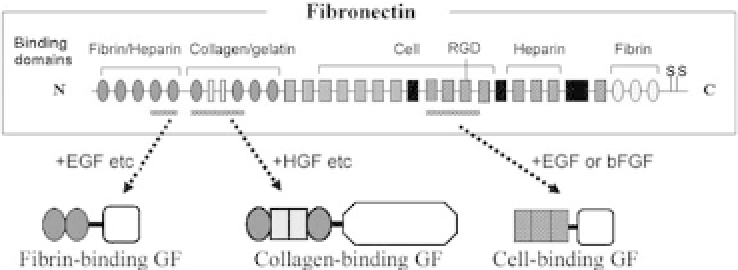Biomedical Engineering Reference
In-Depth Information
surface.However,apossibilityremainsofdamageorconformational
changes after chemical treatment.
17.3 Gene-Engineered Binding Growth Factors
Geneengineeringofgrowthfactorsaimedatconferringhighbinding
a
nity (substantial immobilization) is another means of immobi-
lization. There are many reports on interactions between biological
molecules. For example, the matrix protein fibronectin associates
with collagen at high a
nity via a polypeptide sequence termed
collagen-binding domain (CBD). Fibronectin also comprises a bind-
ing domain for fibrin, cells, and heparin.
9
Binding growth factors
weregeneratedonthebasisoftheknowledgeonthistypeofinterac-
tion, as the major design of these molecules is the fusion of growth
factors with polypeptide sequences that have an a
nity for target
proteinsormaterials.Figure17.2showsexamplesofdesignsthatwe
and others have employed. The resulting proteins exhibit collagen-
binding,fibrin-binding,or cell-bindinga
nity.
Although this methodology requires steps for elaborate produc-
tion of recombinant proteins, once the binding growth factors are
generated, one can simply add them to the target materials for
Figure 17.2.
Construction of binding growth factors by fusion with
fibronectindomains.DNAfragmentsencodingbindingdomainsandgrowth
factors were ligated and incorporated into expression vectors, and recom-
binantfusionproteinswereproducedusing
E. coli
oreukaryoticexpression
systems.
Abbreviations
: GF, growth factors; RGD, cell-binding site sequence
Arg-Gly-Asp.









Search WWH ::

Custom Search